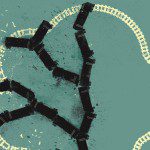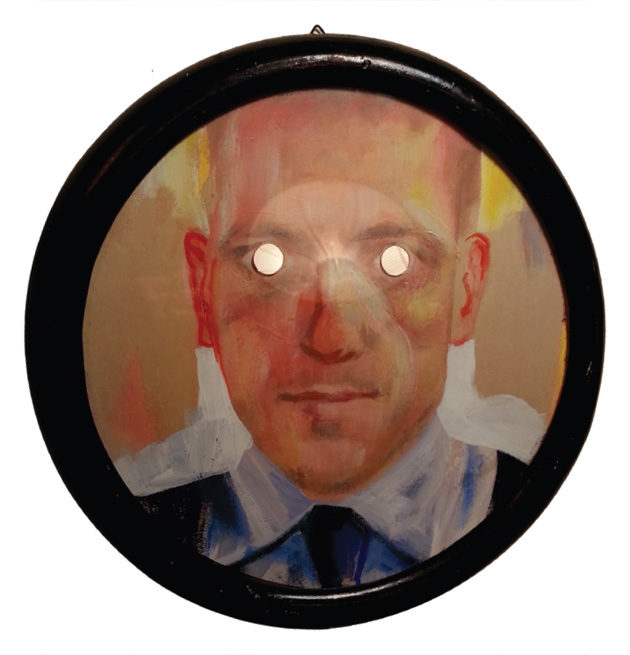April 3, 2014
Krystyna Henke

The secret relationship between reporters and spies
Security intelligence agencies are increasingly powerful in the age of global surveillance—and for investigative journalists, the job is now harder than ever
By Krystyna Henke
It’s about 10 o’clock on a Friday morning in October 2009 when Dru Jay hears a knock. He throws on some clothes and opens the door of his Montreal apartment. A man and a woman stand in front of him. Jay stares at a badge that reads “CSIS.” The visitors ask to come in. He refuses. The agents then ask if they can all go for a coffee somewhere. At first, Jay says no thanks; thenhe thinks, Let’s just keep this close to my place, open and public. He decides that the three of them should walk across the street to a park bench.
Jay, an independent journalist who covers protest movements, is a founder of The Media Co-op, an online grassroots news network. He’s also founding editor of the bimonthly online and print newsmagazine The Dominion. His visit from the Canadian Security
Intelligence Services wasn’t a complete surprise; other activists had written about similar experiences. Still, he was caught offguard,and now admits, “I was a little freaked out.” Jay had reason to be wary. The agents asked him about demonstrations
against the upcoming 2010 Vancouver Olympics. They asked him about oil sands protestors. They wanted to know which groups were active in Montreal. They asked him if he would co-operate if a protest turned violent. Then they told him not to share what was said in their conversation, and asked if they could call him for more information. “The reason they wanted to talk to me,” he says, “was to turn me into some kind of informant.”
But instead of ratting out colleagues, Jay publicized his experience in a blog post. “Independent journalist visited by CSIS” detailed everything Jay could remember about the encounter. “CSIS visits have multiple functions,” he wrote. “On one level, they serve to gather information and recruit informants. On another level, they serve to intimidate people who are politically active, create divisions . . . and plant misinformation.” Further, he added, “The targeting of journalists for CSIS visits is, in this context, all the
more alarming, given the chilling effect—second-guessing and paranoia, for starters—that inevitably results.”
Jay’s experience, while disturbing, is not unusual. Journalists are tempting sources, and government intelligence agencies make it their business to seek out those with privileged information. Reporters might come upon a whistle-blower, a leaked document or an otherwise desirable source. And journalists have “a tremendous ability to add insight to the narrative,” says Globe and Mail investigative reporter Colin Freeze, who covers national security. “We can hop borders with great ease. Governments can’t do that. And we can ask people questions with relative ease.”
A quid pro quo develops between the two groups when journalists want a bit of help poking into hidden recesses of the government. This is how the game has been played for decades, and reporters have always known the score: when they use informants
as contacts, they might end up getting used themselves. That was the deal, but now, with global mass surveillance firmly entrenched, the government can hop any border it wants on its own. In this environment, bargaining power is all but gone, and journalists are no longer sure of their footing.
That doesn’t mean they aren’t going to try to regain it. Almost two decades after police shot and killed Dudley George at the Ipperwash standoff, Canadian Journalists for Free Expression (CJFE), CBC and the Radio-Television News Directors Association are bringing a case before the Ontario Superior Court—they want the Ontario Provincial Police to end its practice of impersonating journalists for the purposes of gaining intelligence. On Labour Day, 1995, a First Nations land-claim protest began peacefully at Ipperwash Provincial Park, near Grand Bend, Ontario. About 30 members of the Stoney Point Ojibway band wanted to reclaim the park, which is on the site of a sacred burial ground, but the occupation turned ugly after a reported 200 OPP officers showed up.
The day before acting Sgt. Kenneth Deane fired three shots at George, two men set up a camera and audio recording equipment and started filming. They claimed they were freelancing for United Press Associates, a fictitious outfit. It was later revealed that they were plainclothes officers. Impersonating journalists is an accepted strategy in the OPP. In fact, according to one of the force’s policy documents, the technique extends to pretending to be “other ‘persons in authority,’ including lawyers, priests and judges.”
At Ipperwash, there was another actor to consider. Toronto Star crime reporter Peter Edwards covered the crisis and discovered that CSIS and the OPP had paid aboriginal journalist Jim Moses Intelligence agencies are increasingly powerful in the age of global surveillance—and for investigative journalists, the job is now harder than ever to supply information about the protestors. “He thought that he was doing a good thing by targeting the First Nations people he thought were criminals,” he says. “And then he felt badly used by the OPP and CSIS.”
Edwards, who reports on biker gangs and the Mafia, worries that such techniques put his integrity—and safety—at risk. “With bikers,” he says, “if they think you’re being two-faced, that’s when you’ve got a problem.” Government recruitment and impersonation
of journalists does more than make the job difficult, he says: “It endangers me.”
Nor is it good for reporters to create the impression they might be working as spies. In an affidavit filed in the CJFE case, CBC reporter Dave Seglins stated that he faced this suspicion in 2009 while covering a Six Nations protest at Douglas Creek Estates, southwest of Hamilton. Because of this, he was unable to interview the main protestors. Farther afield, it can get riskier when the line between agents of the state and journalists becomes blurred. In 2002, Pakistani militants believed Wall Street Journalcorrespondent Daniel Pearl was a spy, and kidnapped and beheaded him.
Nine years after Pearl’s death, the Canadian government admitted Beverly Giesbrecht, publisher of the website Jihad Unspun, had likely died at the hands of the Taliban.
Relations between reporters and intelligence agencies haven’t always been adversarial. During the Second World War, British journalists eagerly carried out censorship, wrote propaganda and took covert assignments. Correspondents who went overseas with Canadian units were embedded as officers. British military censors edited their reports, and readers back home knew little of the process. “Entire incidents were kept out of the papers,” says journalist and historian Mark Bourrie. Reporters wrote positive stories to keep morale high on the home front, and they floated believable rumours to other journalists in Axis countries. One disinformation campaign concerned Italian dictator Benito Mussolini, who, Italians were told, had a Swiss bank account and was going to flee as soon as the Allies invaded. Bourrie says this rumour knocked Italy out of the war. “We were a propaganda arm of our governments,” the late Charles Lynch, who once worked for Reuters, told Phillip Knightley, author of The First Casualty. “It’s humiliating to look back at what we wrote during the war. It wasn’t good journalism. It wasn’t journalism at all.”
During the Cold War, hundreds of U.S. journalists worked with the CIA, providing information and cover for its operatives. The scope of the practice—which involved outlets such as Time, Lifeand The New York Times—was covered up in Senate hearings in 1976. “Journalists in the field generally took their assignments in the same manner as any other undercover operative,” wrote Carl Bernstein in a 1977 Rolling Stone cover story. They recruited spies “and they had the reputation of being among the best in the business.” These journalists planted “subtly concocted pieces of misinformation,” according to Bernstein, even going so far as to offer “propaganda to leading foreign journalists” at social events. They also acted as go-betweens for money and agents, “providing their hotel rooms or bureau offices as ‘drops’ for highly sensitive information moving to and from foreign agents.” Sometimes, according to Bernstein, they manned CIA-funded media fronts such as the Rome Daily American.
Most journalists would have trouble picturing themselves in such situations, but government manipulation—such as disinformation hiding behind unnamed sources—is still commonplace. When the Maher Arar story broke in 2002, many Canadian journalists were quick to
file a manufactured story. The Syrian-Canadian software engineer was on a stopover at New York’s John F. Kennedy International Airport while on his way home to Canada. After an RCMP tip linked him to Al-Qaeda, he was detained, and then deported to Syria, where he was tortured. Relying on anonymous government sources and leaked information, story after story described Arar’s “alleged” terrorist links.
The next year, Ottawa Citizen reporter Juliet O’Neill’s “Canada’s dossier on Maher Arar” made a strong, if not airtight, case that Arar was a terrorist. O’Neill, who declined to be interviewed for this story, received what all journalists dream of: an exclusive leak of highly classified government intelligence. “She had this great story—so she thought,” says retired York University political science professor Reg Whitaker, a member of the Arar Commission of Inquiry’s advisory panel. “She was being used as a tool by these people, who were using their own anonymity.”
Many allegations about Arar, in articles by O’Neill and others, would later prove to be false. Details began to emerge about how government officials carefully selected information, stripped it of context and then leaked it to journalists. O’Neill was not the only one to quote unnamed officials, but she became the poster child for government disinformation disseminated through the media.
“Disgraceful! It’s just disgraceful,” says Andrew Mitrovica, a weekly media columnist foriPolitics, an independent, non-partisan online publication. In a 2006 article in The Walrus, he condemned fellow reporters for jumping on the bandwagon, relying on leaks and collectively branding Arar a terrorist. Mitrovica reviewed at least 2,500 articles and newscasts, and only a few journalists came out unscathed. “We are not supposed to be the PR conduit for the security intelligence services,” he says. Freeze calls the fiasco “putrid journalism.” Then again, he is self-aware enough to wonder whether he would have acted differently had he been in O’Neill’s position.
The difficulty for journalists is gauging when sources are giving good information. Seasoned reporters lean on the basics—they remain skeptical about a source’s motives, they verify and double-check information and they look to official sources and records whenever possible. Victor Malarek, an investigative reporter for CTV’s W5, has spent years developing a network of intelligence sources he can trust. “I have had a couple of very good CSIS contacts who made sure that I was not being fed bullshit.” He met his sources in the intelligence community at national security conferences and by being on different beats over the years. “I had contacts in the CIA, and I used to know a lot of people in the RCMP,” he says. “It takes a long time before they can trust you.” But even with reliable sources and physical documents, things can go wrong—something Malarek learned first-hand when he was a Globe reporter. Someone had leaked him information suggesting that a Sikh refugee claimant named Dr. Santokh Singh had terrorist links. Malarek ran hard with the tip and was aiming for a front-page story. “My editor, when he first saw the file on this guy, said, ‘Let’s go with it now.’” Malarek was about to pursue the story when doubts crept in and made him waver. He asked himself, “Why was this stuff sent to me in a brown paper envelope?” He dug deeper and ended up with a different front-page story—one that unmasked the Canadian government’s efforts to sacrifice Singh in order to strengthen trade relations and appease the Indian government, which was embroiled in a conflict with the Sikh independence movement.
Of course, the basics can only take a reporter so far. In an era of revelations about the NSA’s mass electronic surveillance in the U.S. (mirrored in Canada by the Communications Security Establishment Canada), some reporting conventions may no longer be enough. Journalists must now employ additional techniques to protect themselves.
Matthew Millar, national correspondent and parliamentary reporter for online newspaperVancouver Observer, is aware of these challenges. He assumes the government monitors journalists who cover Parliament Hill. “We’re dealing with sensitive topics,” he says. “When you’re watching the watchers, that can only be expected.” Millar says journalists in Ottawa all take various steps “to protect our sources and to protect ourselves.” Some reporters use disposable “burner” cellphones so they can’t be traced. Millar relies on face-to-face meetings—“the old-fashioned way,” he says. “There’s a lot that I don’t talk about with sources on the phone.”
These challenges require many journalists to calibrate their levels of concern case by case, and sometimes the needle goes over the red line. Paul Palango, formerly an investigative journalist at the Globe, faced this when researching his book that dealt with a number of security issues, including the Arar case. He believed Arar was working for the FBI or the CIA to infiltrate the Syrian prison where he was held.
During Palango’s research, strange things started happening. Three of his computer hard drives were destroyed over a three-week period. His Internet service provider told him to call the police, saying, “Whoever is attacking you is much more sophisticated than we can handle.” He thought the book was “one of the scariest stories I’d ever done.”
When Dispersing the Fog: Inside the Secret World of Ottawa and the RCMP came out in 2008, Palango went on the usual media tour—or he was supposed to. He says that on the night he was scheduled to appear on four major programs, all of them cancelled. Apparently, the book was not up for public debate. Palango realized that Arar was being portrayed as a victim-hero, and no one wanted to disturb that. “If you try to defeat that narrative,” he says, “you’re up against a very powerful force.”
The obstacles reporters face as they go about seeking the truth and informing the public are not all external. They can erect obstacles all by themselves. “It is the routine ways in which journalists do their craft that give rise to disinformation and propaganda,”
says Bruce Wark, a former CBC Radio reporter and retired journalism professor at the University of King’s College. “And some of those ways are the clichés we use. We talk about fairness and balance, and those kinds of things lend themselves to propaganda.” Whether journalists deal with police, or military or secret intelligence sources, there tends to be a bias in favour of the establishment. Reporters often frame stories by giving competing claims equal time, which can obstruct the truth. “The sides aren’t equal,” Wark says. “This requires extra effort on the part of journalists to find out which side is telling the truth.”
The truth can be uncomfortable to those wielding power, which is why reporters often encounter challenges. The government can impose its own agenda on journalists in various ways, including intimidation of the kind two CSIS officers inflicted on Jay that Friday morning in 2009. Jay worries about an uninformed public that takes its democracy for granted. “People don’t know about some basic things that the government is doing, that corporations are doing.” This is one reason he’s remained an independent journalist. Only a media outlet free of government manipulation—“as opposed to these people who have an interest in pulling the wool over our eyes”—can serve Canadians who depend on accurate, reliable information.This piece was published in the Spring 2014 issue of the Ryerson Review of Journalism.
Related Posts
 Mental health: why journalists don’t get help in the workplace
Mental health: why journalists don’t get help in the workplace Stories in the ashes: covering disaster in Lac-Mégantic
Stories in the ashes: covering disaster in Lac-Mégantic What we lose when papers give up on beat reporting
What we lose when papers give up on beat reporting Selling the second-screen experience
Selling the second-screen experience Does political neutrality really mean journalists can’t act in self-defence?
Does political neutrality really mean journalists can’t act in self-defence? Bloomberg News embraces longform journalism in Canada
Bloomberg News embraces longform journalism in Canada
Krystyna Henke was the Visuals Editor for the Spring 2014 issue of Ryerson Review of Journalism.







































